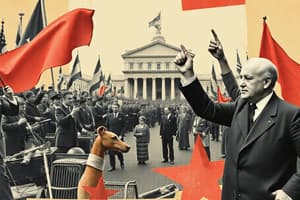Podcast
Questions and Answers
What is the definition of 'Reactionary Gap'?
What is the definition of 'Reactionary Gap'?
- The distance at which an officer should stand when facing a suspect
- The distance you must keep between you and the subject to react effectively against a sudden threat (correct)
- The area in which an officer stands in relation to the suspect
- The area within the danger zone
In what stance should you stand when facing a suspect?
In what stance should you stand when facing a suspect?
- Interview stance and 45 degrees (correct)
- Aggressive stance and facing directly
- Backwards stance and looking over the shoulder
- Sideways stance and avoiding eye contact
What is 'Visual Control' in law enforcement terminology?
What is 'Visual Control' in law enforcement terminology?
- The ability to see the subject's hands and ensure they hold no weapons (correct)
- The way an officer carries themselves
- The distance needed for effective reaction against a sudden threat
- The officer's ability to convey authority verbally
What is 'Body Movement' in law enforcement context?
What is 'Body Movement' in law enforcement context?
What does 'Command Presence' refer to?
What does 'Command Presence' refer to?
What is the purpose of maintaining a reaction gap in law enforcement?
What is the purpose of maintaining a reaction gap in law enforcement?
Explain the concept of 'Danger Zone' in law enforcement terms.
Explain the concept of 'Danger Zone' in law enforcement terms.
How should an officer position themselves when standing in front of a suspect?
How should an officer position themselves when standing in front of a suspect?
Define 'Visual Control' and its importance in law enforcement.
Define 'Visual Control' and its importance in law enforcement.
What does 'Officer Presence' encompass in a law enforcement context?
What does 'Officer Presence' encompass in a law enforcement context?
Flashcards are hidden until you start studying
Study Notes
Law Enforcement Concepts
- Reactionary Gap: The distance an officer maintains from a suspect to allow time to react to potential threats.
Officer Positioning
- Stand at an angle, with feet shoulder-width apart, to maintain balance and react quickly to potential threats.
- Position yourself at a 45-degree angle to the suspect, with your body facing forward and your eyes on the suspect.
Visual Control
- Visual Control: The officer's ability to observe and assess a situation, watching for non-verbal behaviors and body language cues.
- Importance: Enables officers to detect potential threats, build trust, and de-escalate situations.
Body Movement
- Body Movement: A suspect's non-verbal behaviors, including body language, tone, and facial expressions, which can indicate intentions or emotions.
Command Presence
- Command Presence: An officer's confidence, assertiveness, and professionalism, which can help de-escalate situations and establish authority.
Purpose of Reactionary Gap
- The purpose of maintaining a reaction gap is to provide officers with time to react to potential threats and protect themselves and others.
Danger Zone
- Danger Zone: The area within arm's length of a suspect, where an officer is most vulnerable to attack.
Officer Presence
- Officer Presence: A combination of visual control, command presence, and body language that enables officers to establish authority, build trust, and de-escalate situations.
Studying That Suits You
Use AI to generate personalized quizzes and flashcards to suit your learning preferences.


